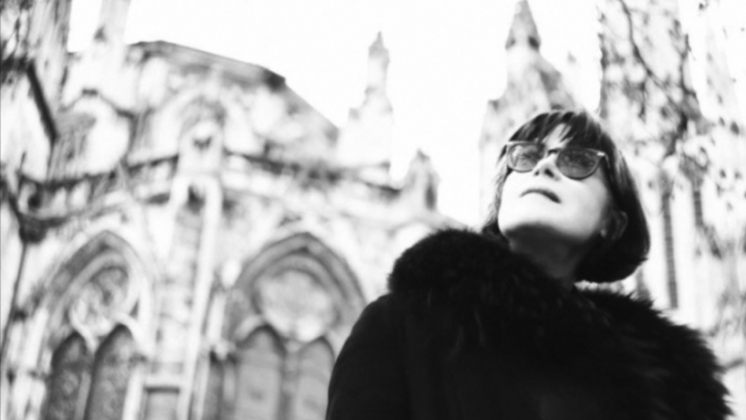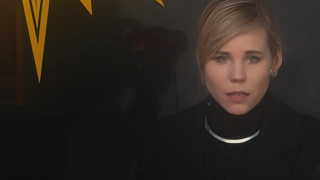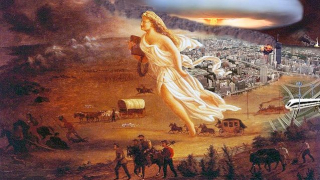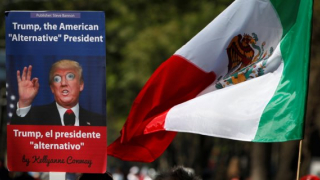Metaphysics of Censorship
The Frontier and the Censor
In this thesis, we will discuss not so much the pragmatic and technical functions of censorship, but its special intellectual and metaphysical status.
By definition, the censor is situated at a specific point in semantic and intellectual space, i.e. on the borderline between different cultural worlds, on the line drawn between 'this' and 'other', between being and nothingness, between the one and the many, between the 'other' and the 'other'. This borderline is not a thin line, a line on a plane, separating traditions, societies and worldviews. It represents a three-dimensional territory, a qualitative universe of meaning (with horizontal and vertical dimensions), which Daria Dugina has called 'frontier', a space of semantic intersections, interactions, clashes, disagreements, wars, treaties and reconciliations. There is a horizontal censorship and a vertical censorship: in the first case the superficial, planar, factual, phenomenological layers of cultural spaces are juxtaposed, while in the second case the deep, essential layers of meanings are juxtaposed. The censor stands at the complicated intersection of inside and outside, of traditions, worldviews, mental paradigms, stereotypes, spiritual practices and theoretical perceptions. He presents himself as researcher, expert and judge, admitting into his territory 'something foreign' - alien, coming from the 'other side', different in value, ideologically incomparable. At the same time, the censor acts as a frontier post, a guard who opposes hostile meaning and refuses certain contents to penetrate his own culture. The censor defines the possibility and boundaries of substantive contacts and assimilation of ideas, ideologies, values; he passes judgement on the proximity or incompatibility of confronting ideas and worldview principles (encountered on the frontier). It acts as an intellectual frontier guard, it is responsible for the 'frontier' wars, the areas between worlds - semantic, cultural, civilisational. It watches over how a set of theses fits into the context of another culture's provisions.
Looking at the functions of censorship in the New Age society, we can say that censorship was mostly perceived as a mysterious sacred act aimed at limiting access to secret knowledge, initiating the weak-minded, and at the same time providing access to the same knowledge and skills to the strong-minded and decent people. The dual function of censorship implied a high degree of mastery on the part of the censors of the principles and paradigms of the cultures present in the borderlands, the ability to diacrisis (to distinguish) and to search for the unity of cultures, elevating them to a possible higher unitary foundation.
The guardian of the threshold
In mythology and in religious initiatory practices there is a special character, the Threshold Guardian, who is supposed to meet the hero, the spiritual wanderer, the seeker of a magical object or knowledge on the borderline ('level gap'), make a kind of certification of his initiatory status and let the hero pass if his qualities meet the requirements for passage to a new level, or forbid passage if the potential hero is untenable. The censor is, in a sense, a participant in the initiatory action: both guardian and guide. He has to guard the values of one side of the border against the challenges and encroachments of the other side, and at the same time help them to interact osmotically, to oppose, to make contact, to penetrate each other. The customs service of the 'threshold guard' is a test for the hero who tries to cross the border, the 'red line', and for the guard who decides whether someone or something, as the bearer of some knowledge, meaning or action, is worthy of facing the border, the other culture, the plot of the alternative world, the new topoi given to other gods. Its task is to pass on the strong impulse and creative sense and to frighten away the weak and unworthy essence. The modern world cynically presents us with a simulacrum of such a censor: the 'face check' at the entrance to a disco. In Russian fairy tales, the older siblings of the conditional Ivanushka the Fool, going in search of a missing person or a magical object, often disappear and then are found standing at a certain threshold.
Censor: sovereign priest-warrior
The boundary line that connects and divides different worlds is dangerous, unexpected and ruinous. The censor (the guardian of the threshold) must determine whether both sides are ready to meet: crossing the threshold may require a sacrifice, a symbolic price of admission. Procrastination, that is, indecision, the postponement of the passage to a new level, is the most important psychic phenomenon of crossing the threshold, of reaching the new. The censor lifts the veil, in this sense he is the overlord. The censor is a filter. He is a guide, a stalker. To perceive the other, the new, he must perform an act of dissolution, dissolving dogmas and hardened filters. The censor is invited to become an alchemist, to dissolve the habitual stereotypes of perception and at the same time to be able, while changing, not to change. He is called upon to upset the old system of agreements and conventions and to allow the new to adapt, i.e. to act in a risky, extreme, dangerous way. The censor must be both a sage - to know and understand - and a warrior - to dare to break limits and fight for them. He is called upon to be both sovereign, sacred king, destined to set canons and fight for them, not to retreat, not even to retreat.
Censors in a fairy tale, the gestalt of Baba-Yaga
Censorship is the practice of connecting and disconnecting theses, doctrines, dogmas and Logos, all at the same time. It is the overlapping and simultaneous comprehension of two opposing intellectual contents, it is their defence and at the same time the risk of their mixing, discrepancy, disproportion, when one content inserts itself into the other, when the 'many' absorbs Unity (as in the last hypotheses of the Platonic 'Parmenides'), when 'this kills that' (as in Victor Hugo's novel 'Notre Dame de Paris'). Censorship is the archetypal situation of the encounter between 'this and that', between the world of the self and the world of the other, between the conscious and the unconscious, between the world of the living and that of the dead. It is a duel between life and death. V.Y. Propp, an ingenious restorer of the structures of Russian fairy tales, sees the peripeteia of his protagonists as a great initiatory journey to the borders between life and death, between the forest and the underworld, where the 'guardians of the threshold' (custodians of initiatory practice) and therefore censors are Baba-Yaga, Snake-Gorynych, Koschey the Immortal and other sinister characters.
Bifurcation of the censor. Schizophrenia
Censorship implies a significant destabilisation of the normal perception of the world, causes an experience of cognitive dissonance and a clash between the semantic contents of different epochs and spaces. In a certain sense, the censor loses contact with normality, his consciousness inevitably splits, he experiences a real inner confrontation, turning into a schizophrenic. The frontier of censorship can be associated with a leap, a breaking of the level, a trauma both for the undercensor who undergoes this experience and for the actor who performs the censorship, i.e. both the subject and the object of censorship, who can sometimes combine these sides of the process and exchange statuses.
Against the apeiron
Censorship is the supervision and control of certain intellectual activities. Is it only on some of them? Or on all of them? It seems to us that we must emphasise the universal and all-encompassing nature of prohibitions and restrictions on thought, utterance, speech, the Logos in the human universe. Interestingly, the very existence of boundaries, i.e. the distinctions between one and the other, is the position of the limit of a certain sequence of transformations, i.e. the implementation of censorship. The boundary (Greek πέρας) was always hailed in ancient Greece as order and harmony, whereas the term apeiron (ἄπειρον) 'unlimited', 'indefinite' meant immeasurable destructive chaos, which required overcoming.
If we turn to the Platonic tradition, censorship turns out to be a pervasive process. In Plato, the holistic dynamic of the world is expressed in the formula 'to put the seal of eternity on the process of becoming'. Eternity (ideas, eidos, ideal structures of the world) censors movement, change, becoming.
The censorship of the Gnostic myth
The universality and constructiveness of censorship on the one hand, and at the same time its repressiveness and limitation on the other, is curiously illustrated in the Gnostic versions of the early Christian communities, which insist on the principle of the duality of the world, on the presence, alongside the perfect pleroma of heaven, of an imperfect, failed, evil creation of the world from a 'dark light', the presence of some crack in God. With the Gnostics, an 'evil censor' appears in the person of the 'evil demiurge', who has emerged from the secret nerve of the great Godhead and seized a set of powers from the absolute fullness (pleroma), creating a limiting transition line from the lower material universe to the spiritual aeons of heaven. This ignorant and imperfect guardian of the lower spheres of the cosmos, who usurped the divine powers and kept the fallen human soul in the alienated material world, exerts precisely a cosmological censorship in the Gnostics, closing off the soul's return to the higher realms of the divine aeons. Thus the Gnostic demiurge does not appear as an omniscient and all-encompassing mediator of the contiguous worlds (good censor), but as an unlettered and limited jailer-archon, who seeks to prevent the human soul's passage through the gate of salvation upwards, towards heaven, consigning it to misfortune (Εἱμαρμένη), of necessity, to the demiurge's casemates. Interestingly, the indication of universal censure within the pleromic universal order is contained in the very foundation of the Gnostic myth of the dark light of the supreme God, the ignorance, conjecture and rebellion of Pistis Sophia, who discovered the higher aeons of the celestial plenitude (pleroma) and for her curiosity and audacity of anti-hierarchical rebellion was plunged by punishment into the lower regions of the cosmos. In other words, in Gnostic dualistic Platonism, the behaviour of the aeons themselves is censured, and Pistis Sophia, having violated the world order and wishing to approach the ineffable abyss, is thrown down, simultaneously becoming both a breaker of the order that rebels against censure, i.e. the subject of anti-censure, and the object of censure by aeons higher than herself. Furthermore, Sophia (in the Gnostic Valentinus) produces a demiurge that creates the dividing line between the fullness of heaven and the cosmos-universe. Sophia becomes the object and subject of censure, first by violating the order and illegally wishing to approach the higher aeon - the depths - and then by being discarded by the guardians of the order, censors of the heavenly rock, she herself creates the demiurge who becomes the censor and creator of the dividing line between the high and the low of the universe.
Another important metaphysical value of the censor is its protective, apophatic function, the function of concealing the ultimate foundations, the possible depths of the primordial, of the Father, of the Pervaeon, of the Absolute, of the absolute power, of the power of any and all existence. The unfathomable depths are expressed in absolute silence, comparable to the absolute censorship (prohibition) of the Word, of the Logos. The rebellious Sophia of the Gnostic pantheon, eager to know the truth of the primordial, aspired to the highest abyss of the unspeakable essence of the pleroma, but her inability to penetrate it threw her into pain and perplexity, provoking an encounter with the limit (ὅρος), which put everything in its proper order and restored her place in the pleroma, sending her to the lower regions of space. The purpose of such censorship is to rehabilitate order and restore true proportions.
A pyramid with the apex cut off
A paradoxical vision of great metaphysical censorship is present in the phantasmagorical doctrine of the 20th century Romanian philosopher with a strong Gnostic bent, Luciano Blaga. The main figure in Blaga's philosophy is the Great Anonymous, the supreme principle, the Absolute, the centre of creative power. If the Great Anonymous, Blaga argues, acts in the mode of its absoluteness, then all its creations will also be absolute, leading to two or more 'Absolutes'. However, there can only be one Absolute. The emergence of a 'second Absolute' would violate the absoluteness of the first. For this reason, the Absolute deliberately implies in its creations an imperfection and an inability to recognise its totality as Absolute, because to fully recognise it is to become Absolute. This is 'transcendental censorship'.
With the Good, the situation of such censure is symbolically represented in the form of a pyramid, with the top cut off and separated from the base. Man in his cognition can only reach the plateau of the trapezoidal volumetric figure. This upper surface of the truncated pyramid, the limit of knowledge and approach to divine knowledge and revelation, is what Blaga calls the 'mysterious horizon'. Above it towers the summit of the pyramid, never reached by man in his knowledge or mystical experience.
Man, according to Blaga, is an animal that has undergone an "ontological mutation": he aspires to look "up there", "beyond the immediate, in the perfection of the transcendent", and to dwell "in the horizon of mystery and revelation". It is he who yearns to know the unknowable Absolute, but can never do so, because then he would become equal to God, which is impossible, because censure leaves an eternal distance between man and God.
Culture is an aspiration to overcome censorship, it is a launching into the impossible, culture is not utilitarian, it is mysterious and metaphorical. Civilisation, on the contrary, is the desire to maintain censorship. It is functional and technical. Culture is creativity, civilisation is production.
It seems to us that even the Kantian idea of the transcendental character of human knowledge and the unattainability of the transcendental thing in itself can be seen as a total censorship imposed on human cognition by an unknowable someone.
In principle, censorship is any existing or proclaimed veil, barrier, chador or veil (including the veil on a woman's hair).
Censorship in paradise
Censorship is the restriction or prohibition of a word, thought, action, practice, expression or system of opinion that does not conform to the laws, guidelines, policies, rules, traditions, norms, etc. accepted by a community or society. God in paradise forbade Adam and Eve one action: eating from the tree of the knowledge of good and evil. This was perhaps a ban on the dualism of the world, its division into good and evil, a ban on knowing what is evil.
Do we not see here the first gestures of restriction of freedom, the first echoes of censorship? Paradise itself is a kind of happy place separated from the other world by a boundary - a place essentially subject to divine censorship in its goodness of separation. But even in the good place, further censure is necessary, namely to define the boundary of what is considered unacceptable, evil, unacceptable, punishable by death. A second act of good censorship on God's part?
Censoring the animal
In the theory of psychoanalysis by Z. Freud's theory of psychoanalysis has two instances responsible for censoring the unconscious: the structure of the self and the structure of the superego. At the same time, the space of Freud's anti-censorship is dreams as the unfolding of repressed and displaced desire. Hence Freud's famous slogan 'Learn to understand your dreams!
Man - said Aristotle - is ζῷον λόγον ἔχον. The animal that possesses the Logos, or the animal that possesses the Logos. We see here the dividing operation between the 'mere animal' and the 'animal that possesses the Logos'. Is not the boundary drawn by Aristotle the line that accentuates the fatal irreversibility of human destiny, which means the prohibition for man to be an animal, to lose his enlightenment by the Logos - that is, the step of an irrevocable full censure of God or nature? Incidentally, the formulation of the last part of the question on the subject of censorship and the answer to this question itself depend on the coordinate system, the paradigm in which we find ourselves and reason. And here a certain digression on paradigms is necessary.
Paradigms
Let us start from the fact that the very ontological status of censorship, as well as its interpretation in epistemology, depends on the paradigm of thought, which persists and is shared by humanity or a defined part of it at a given historical moment or in a given region of space. In particular, from the theory of the three global metahistorical paradigms identified by Rene Guénon and the traditionalist philosophers of the 20th century (Tradition and Modernity) and studied and described in detail by A. Dugin (cf. A. Dugin 'Postphilosophy'), who identified three fundamental paradigms: Tradition, Modernity and Postmodernity. All have succeeded each other in human history, although they have often coexisted in parallel, in continuous intellectual rivalry, in mental wars - wars of the mind, which Aleksandr Dugin called 'noomachia'.
What is a paradigm? It is a system of preferred world-view orientations, constructed hierarchies of principles, value systems and structures, which logically precede (precede) any coherent theological, philosophical, scientific discourse, utterances of everyday consciousness, discourses, texts of a certain historical epoch or space of civilisation. In this way, a series of integral languages anticipates and encompasses any speech act. A paradigm is a thesaurus of thought-forms, thought-principles governing the production of knowledge, structuring the laws of being, praxis, poesis (creativity) of a particular society or set of societies of a certain epoch; it is the sum of fundamental mythologems, theologems, philosophemes, sociologems, often hidden, not visible on the surface, that substantiate the strategies of social being and understanding of the world; it is a continuum of basic worldview principles, higher foundations that determine the forms and rules of thought and action, politics, economics, educational models, production, creativity, craftsmanship, etc. д. The paradigmatic approach to the history of thought, philosophy, science and language presupposes that behind concrete systems of worldviews, knowledge, theories and human practices lie profound paradigms, patterns, structures and principles of this concreteness, in most cases conscious, reflexive and agreed upon by a certain consensus of intellectuals and the ruling classes of society. These paradigms do not lie on the surface, are not specifically articulated and, as a rule, reveal themselves in times of crisis, in times of change, collapse and shifting paradigms. In quiet times, they are hidden under the weight of concrete theories, conglomerates of facts, contents and sequences, withdrawn deep into the public consciousness. But at the same time, paradigms (until the moment of their change) remain unshakeable, even if implicit, and they transmit from the depths and govern without alternative, determining the character of the definition of society's goals, the typology of its worldview, the statute of thought, the nature of theories, the meaning of concepts, the character of social projects, the strategies of philosophising, the types of values and objectives.
The paradigm of Tradition
How can the paradigms of Tradition, Modern and Postmodern be briefly characterised?
The Tradition paradigm is based on the principles of theocentrism, the divine creation of the world and man, verticality, hierarchy, holism - recognition of the integrity and interconnectedness of all elements of creation, the interdependence of the parts of the universe, the mutual responsibility of the parts of the whole. Man is understood here as an agent of divine providence, an associate of the intelligent angelic host, who sees his goal in perfection, in ascending the heavenly ladder towards the One (God), in transfiguration, in deification (the Orthodox tradition says: 'God became man so that man might become God'). Tradition links eternity and becoming, seeing time as a seal of eternity in becoming, as an image of the One in many ways. Space is understood in Tradition as sacred, heterogeneous, qualitative, saturated with meanings and traces of sacred history.
Modernity
Modernity revises the paradigm of Tradition, considering it an obscure and exhausted past; it relativises the idea of God, renounces theocentrism, verticality, hierarchy, and eternity; it desacralises the Church, mechanises the concepts of time and space (claiming a unidirectional time without eternity and finality and an isotropic quantitative space), and focuses on progress and development
In anthropology, Modernism constructs a model of atomistic individualism, proclaiming man free from God and vertical ontology, and relying on the principle of anthropocentrism and the autonomous individual, built in the image and likeness of Democritus-Epicurus' free indivisible atom. The designated individual proclaims himself independent of the vertical hierarchy, the church, the state, the community, the people, the ethnos and all other collective 'idols' (or, more precisely, eidolon, 'ghosts'), be they 'ghosts' of the 'cave', the 'clan', the 'market', the 'theatre', etc. (F. Bacon). The paradigm of Modernity declares the birth of the atomic individual, who has abandoned the notion of the 'common' or of species and gender ('nominalism'), who has rejected all hierarchies and collective identities, generic prejudices and phantasms, and who has proclaimed the advent of the free individual entrepreneur, turning to facts and utility, to 'reality' in its pure becoming, to physics and matter, and finally to the only authenticity of value in the person of one's rational 'I' ( R. Descartes - Descartes).
Postmodernism
The main meaning of the next era, Postmodernism, consists in the further liberation of the individual from the remnants of collective identity, to the point of its disintegration into its constituent parts. Postmodernism pursues the idea of radical emancipation or liberation itself, removing from the individual all the last definitions and qualities, which in the paradigm of Tradition structured the essence, the identity of the individual, and which in Modernity were subsequently relativised and eliminated. Postmodernism considers Modernism inconsistent in freeing man from the 'bondage service' to the Logos, to Mind, to hierarchy, to verticality; it invites him to abandon the unlived mirages of history, the qualities and definitions that bind him to collective structures - attachment to country, nation, state, gender and language. In postmodernism, the human being is insistently proposed as a migratory entity, a nomad without possessions, a tourist of the world with a computer, who settles in random places according to the will of the labour market. This man of the world can hardly have beliefs, thoughts, goals; he is hardly able to think or plan his life, because a thought is "a chain of bandages with the Mind, the Logos", while a project is "utopia", "constraint", "non-freedom" to change the direction of his movement (becoming) at any time. Everything that in Tradition was subject to the scrutiny of eternity (values, ideas, ideals, etc.) in Postmodernity is scrapped. The free being of the new man floats on the river of formation like a 'rhizome', a root beneath the ground, growing chaotically, in an arbitrary direction, but almost always horizontally, only occasionally releasing shoots upwards. The state, the nation, the people, the ethnos, any collective, community, clan, family, community of like-minded people - 'illusions and delusions of the past', which, with proper practice, will dissolve like castles of air, mist over water.
Postmodernism wants to liberate the new being from projects, from thoughts, from meanings, from history, from any determination, including that of the whole. Man - this sounds 'too holistic', 'too totalitarian'. It is necessary to give each human element, each organ, the possibility to 'live a life' independently and freely and also necessarily to express itself in a 'parliament of organs' (J.Deleuze, F.Guattari, B.Latour), or rather, not even to express itself, but to emit a free reply or sound - a meow or a growl (although even the imitation of an animal language takes a radically atomised being of the Postmodern from free expression to the collective language of animals). The language hitherto spoken by humans is 'an absolute totalitarian machine of human coercion and limitation'. It is to be replaced by the individual utterances of individual organs, organic replicas - gurgling and bellowing. In effect, the autonomous individual of Modernity, which appeals to true emancipation, should in Postmodernity become a dividuum, divisible, so that each particle can indulge at will, 'existentialising', loving, kissing without completeness, voting, running forward or sideways without purpose or meaning. Gender should also be seen as a final restriction, which could be discarded or exchanged without regret, depending on the situation and the moods of the smaller parts of the organism.
The strategy of dissolution of man in Postmodernism appears at first as a disturbing and chilling caricature of the concept of his divine creation as conceived in the paradigm of Tradition. But a closer look reveals that the main nerve of the logic of the descending sequence of shifting paradigms is precisely the line of weakening, degrading and ultimately eliminating man as such.
The paradigm depends on the consensus of the intellectual elite
Guénon brilliantly noted that modernity, which has overthrown the world of Tradition, is by no means the result of the objective course of history. It is the product of the desperate activity of a collective subject - a group of intellectuals, scientists and philosophers from the New Age, i.e. the Western sector of humanity. It is based on a preconsidered and distinct intellectual matrix, which has a rigorously verified logic, inverse to the logic of the paradigm of Tradition, and a decidedly reflexive strategy of thinking that overturns the thinking of humanity of the age of Tradition. At the same time, the principles of the Modern, as formulated by the philosophers of the late Middle Ages, the age of disputes over universals (12th to 14th century), and the New Age, not only actively oppose the traditional views of Antiquity and the Middle Ages, but also claim to dominate the European intellectual space - by exclusivity, uniqueness and universality.
Why are paradigms in general, and the paradigm of the present in particular, not always actualised and recognised? Because paradigms are embedded in thought as operating systems, which become an intuitive background for all thinking and are simply not noticed by the users who absorb them along with the school curriculum, the workings of the life-world, habits and stereotypes of perception. Today, it is the paradigm of Modernity and its extreme version - the paradigm of Postmodernity - that implicit, underlying, but most important, fundamental assumption, that dominant structure of meta-language that predetermines the boundaries of statements and the boundaries of a modern person's world. It is the type of language and way of thinking that ultimately determines the arrangement of worlds, be they modern or traditional. What is important is that this operating system of modernity is an imposed, man-made, artificial and manipulative structure, a kind of machination, simulacrum and illusion.
Every paradigm has its censorship
Dealing with the logic of the paradigms of thought in human history, in the context of this article we should naturally link the topic of global thinking, the paradigms of worldview (Tradition, Modern and Postmodern) and the topic of censorship.
Here, for the moment, we can limit ourselves to a few main and somewhat rhetorical questions: is not every paradigm of thought a way of exercising censorship? How does the change of paradigms and the quality of each one determine the dynamics and logic of human emancipation or subjugation? Is the claim of emancipation of the human being by the paradigms of the Modern and Postmodern not a fiction, a false perspective, that moves the human being from the tracks of one type of censorship of human life to the tracks of another type of censorship, also narrowly focused? Moreover, in the first case (Tradition), it is the censorship of the 'gardens of paradise', on the tracks of the 'vertical orientations', in the space of the great return to the sources (ἐπιστροφή) of the ascent and deification of man, while in the second (Modern) and the third (Postmodern) the highest expressions of the human spirit and soul are rather censored, the human worlds are confined to raw matter and corporeity, to suffocating economy and pragmatism, to profit and utility, to individualistic abandon and the dissolution of the human in the hell zines of the Great Mother.
List of references:
Deleuze J. The Logic of Meaning. Moscow: Academic Project, 2010.
Deleuze J. The Fold. Leibniz and the Baroque. Moscow: Logos Publishing House, 1997.
Deleuze J., Guattari F. Anti-Edipus: capitalism and schizophrenia. Ekaterinburg: U-Factoria, 2007.
Dugin A. Post-philosophy. Moscow: Academic Project, 2020.
Dugin A. G. In search of the obscure logos. Moscow: Academic Project, 2014;
Dugin A. G. Noomachia. Three logos. Moscow: Akademicheskiy proekt, 2014.
Dugin A.G. Noomachia. Geosophy. Horizons and civilisations. Moscow: Academic project, 2017.
Dugin A.G. Noomachia. The logos of Turan. Indo-European ideology of verticality. Moscow: Academic Project, 2017.
Dugin A.G. Noomachia. Horizons and civilisations of Eurasia. Indo-European heritage and traces of the Great Mother. Moscow: Academic Project, 2017.
Dugin A.G. Noomachia. Iranian logos. The war of light and the culture of expectation. Moscow: Academic Project, 2016.
Dugin A.G. Noomachia. The Great India. The civilisation of the absolute. Moscow: Academic Project, 2017.
Dugin A.G. Noomachia. Hellenic logos. The valley of truth. Moscow: Academic Project, 2016.
Dugin A.G. Noomachia. Byzantine logos. Hellenism and empire. Moscow: Academic Project, 2016.
Dugin A.G. Noomachia. Latin logos. Sun and cross. Moscow: Academic Project, 2016.
Dugin A.G. Noomachia. Germanic logos. The apophatic man. Moscow: Academic Project, 2015.
Dugin A.G. Noomachy. The French Logos. Orpheus and Melusine. Moscow: Academic Project, 2015.
Dugin A.G. Noomachia. England or Britain? Sea power and positive subject. Moscow: Academic Project, 2015.
Dugin A.G. Noomachia. Civilisations of the New World. The pragmatics of dreams and the decomposition of horizons. Moscow: Academic Project, 2017.
Dugin A.G. Noomachia. Eastern Europe. Slavic logos: Balkan ships and Sarmatian style. Moscow: Academic Project, 2018.
Dugin A.G. Noomachia. Non-Slavic horizons of Eastern Europe: ghoul song and the voice of the deep. Moscow: Academic Project, 2018.
Dugin A.G. Noomakhia. The realm of the earth. The structure of Russian identity. Moscow: Academic Project, 2019.
Dugin A.G. Noomakhia. Russian history. The people and the state in search of a subject. Moscow: Academic Project, 2019.
Dugin A.G. Noomachia. Images of Russian thought. The solar tsar, the glow of Sophia and subterranean Russia. Moscow: Academic Project, 2020.
Dugin A.G. Noomachia. Semites. Monotheism of the Moon and the Gestalt of Va'al. Moscow: Academic Project, 2017.
Dugin A.G. Noomachia. The Hamites. North African civilisation. Moscow: Academic Project, 2018.
Dugin A.G. Noomachia. The logos of Africa. The people of the black sun. Moscow: Academic Project, 2018.
Dugin A.G. Noomachia. The yellow dragon. Far Eastern civilisations. China. Korea. Japan. Indochina. Moscow: Academic Project, 2017.
Dugin A.G. Noomachia. Oceania. The challenge of water. Moscow: Academic Project, 2018.
Jonas G. Gnosticism. (The Gnostic religion). SPb: Lan', 1998.
Caiua R. Myth and Man. Man and the sacred. MOSCOW: OGI, 2003.
Kerenyi K. Dionysus: Proo6raz of inexhaustible life. Moscow: Ladomir, 2007.
Korben A. The dramatic element in Gnostic cosmogonies // Magic Mountain. 2007. NO. XIII.
Quine, W.W.O. Ontological Relativity. M.: Logos, 1996.
Latour B. There was no new time. Essays on symmetrical anthropology. St Petersburg: European University Press, 2006.
Moss M. The social functions of the sacred: selected works. SPb: Eurasia, 2000.
Propp V. Я. The historical roots of the magical tale. L.: Leningrad State University Publishing House, 1986.
Blaga L. Les differentielles divines. P.: Librairie du savoir, 1990.
Blaga L. Trilogy of knowledge. P.: Librairie du savoir, 1992.
Blaga L. Trilogy of culture. P.: Librairie du Savoir-Fronde, 1995.
Schmidt C. (Hrsg.) Pistis Sophia, ein gnostisches Originalwerk des dritten Jahrhunderts aus dem Koptischen übersetzt. Leipzig: Hinrichs, 1925.
Translation by Lorenzo Maria Pacini













